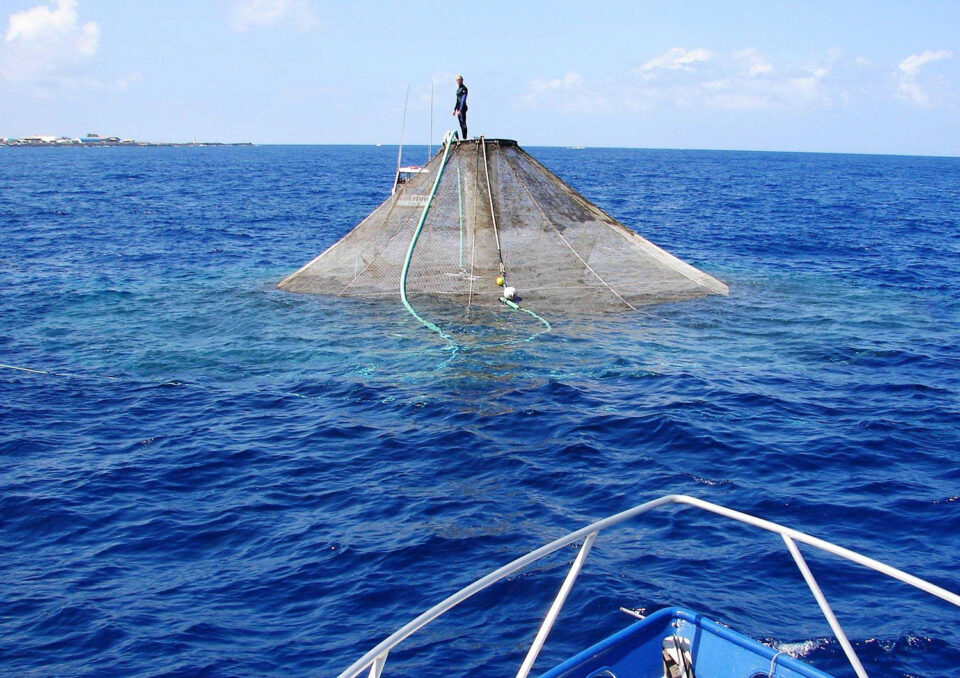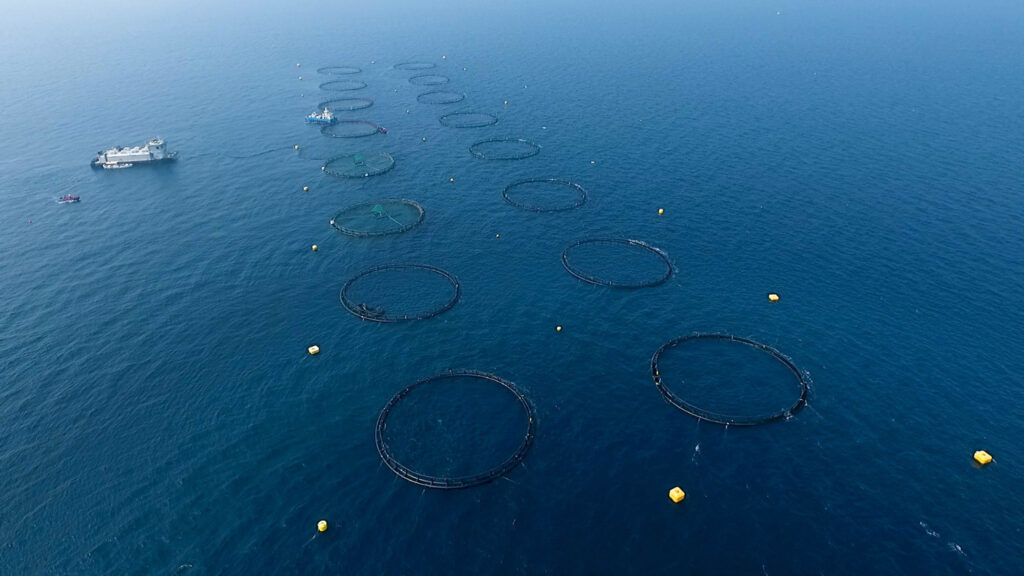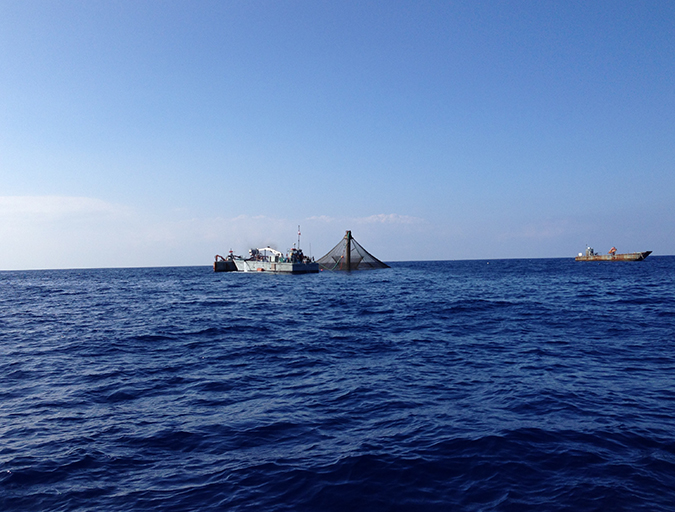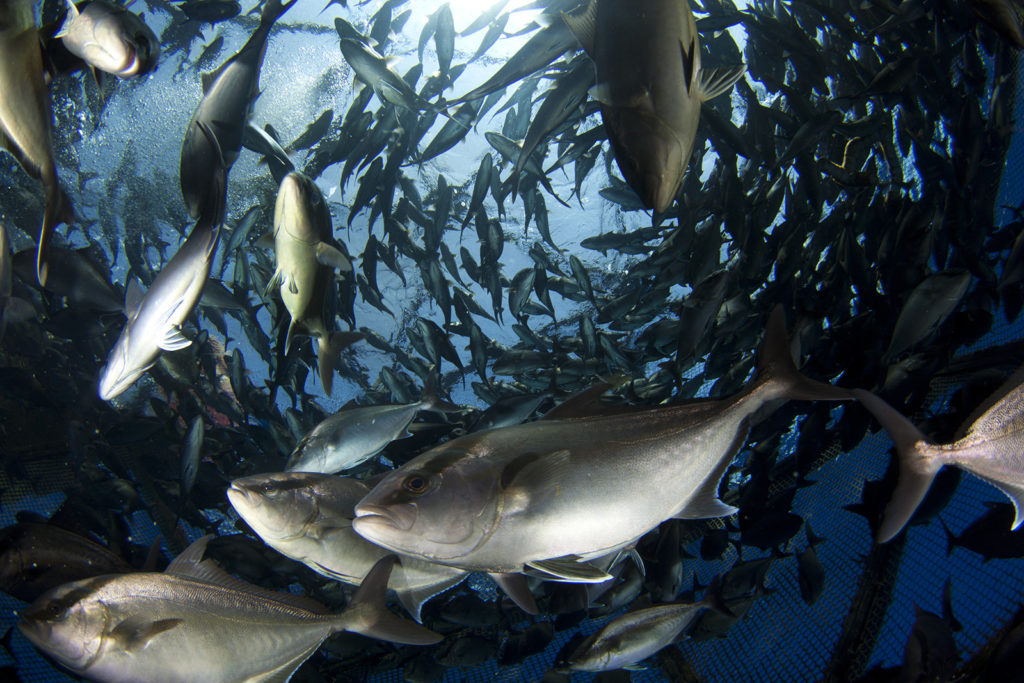Assessment of challenges and opportunities for this technology offers opportunities to improve, expand commercial fish production

Industrial marine fish farming is relatively young but has grown to be a major industry in many regions of the world, producing some 6.6 million tons of fish per year. The standard production units – sea-cage fish farms – are variations on a common theme: floating, surface-based structures holding large nets that contain thousands to hundreds of thousands of fish. The genesis of this technology came from the first Atlantic salmon farms in the 1960s and 1970s in Norway and Scotland, where nylon trawl nets were hung from wooden or polyethylene pipe structures.
Stepwise innovation of this technology has generated the modern, highly engineered structures that dominate production today, with nets hung from either steel platforms or circular plastic rings. Globally, most major commercial marine finfish culture operations have adopted this production system, as it is proven effective and comes production-ready “off the shelf.”
Despite their widespread use, a range of issues is associated with surface-based production, including net deformations and cage breakdowns from storms, which can lead to escape events, parasites and diseases, algal and jellyfish blooms, and the presence of less-than-optimal culture conditions such as high temperatures, low oxygen levels and contaminants from freshwater inputs. Further, several commercially important species such as sea bream, Atlantic cod and cobia utilize bottom and shallower parts of the water column as their habitats, so production in surface sea cages may not provide ideal conditions.
Culture in submerged cages, whether temporary or permanent, could alleviate the extent or severity of many of these issues. Deeper environments typically have more stable temperatures and salinities, largely avoid the full impact of storms and are less favored by the infectious stage of problematic parasites. The adoption of submerged cages may also unlock new areas for production where surface-based sea-cage technologies are inappropriate due to surface wind and waves, or by social constraints like space conflicts with other coastal users.
This article – adapted and summarized from the original publication (Sievers, M. et al. 2021. Submerged cage aquaculture of marine fish: A review of the biological challenges and opportunities. Rev Aquac. 2021; 00:1–14] – provides an overview of the current status of submerged culture worldwide; outlines the biological challenges that different fish species with fundamentally different buoyancy control physiologies face in submerged culture; and focuses on the behavioral, physiological, biological and environmental considerations and challenges.
Status of submerged cage aquaculture
Submerging culture of fish has been carried out since at least the 1970s, with early experiments on rainbow trout and more comprehensive trials in the 1980s with Atlantic salmon. These were largely either short-term submergence or shallow depths and were often attempts to avoid temporary hazardous surface conditions (e.g., extreme winter surface cooling). In the last decade, there has been a considerable surge in research into submerged culture (Fig. 1). To date, at least 11 finfish species have been produced, largely experimentally, in submerged cages of various sizes, at different depths and over various submergence durations.
Fig. 1: Relative research effort over time on submerged cage finfish aquaculture, measured by the number of journal articles published in each year (Web of Science: ‘submerged or submergence or submersible AND aquaculture OR mariculture OR “fish farm*”’). Dots represent studies presenting empirical evidence of the outcomes of submerged culture), with references provided for the first published evidence of submerged culture for each fish species. Numbers within dots represent the number of studies for that year (if >1).
Several species appear to cope and grow well in submerged cages, including cobia (Rachycentron canadum) and Almaco jack (Seriola rivoliana), yet few species have been produced at truly commercial scales in submerged cages. There has been considerable and growing research interest into the submerged culture of several species that have not yet been produced at full commercial scale. Commercial-scale proof-of-concept testing occurred in the early 2000s for Atlantic cod (Gadus morhua), primarily in response to concerns over limited coastal sites available for production in several countries. Amberjack (Seriola dumerili) and red porgy (Pagrus pagrus) have also been shown to experience good growth rates when submerged compared to wild fish and surface-reared fish, respectively, but we are unaware of commercial-scale efforts.
Worldwide, interest in commercial submerged Atlantic salmon farming is growing, with farms deployed or under development in New Zealand, China, Chile and Scotland. This has been spurred by a rapid development towards commercial-scale production. For instance, in response to a Norwegian government scheme to support new technological concepts to tackle the aquaculture industry’s environmental challenges, several companies have proposed submerged cages in their successful applications. These include Norway Royal Salmon’s Arctic Offshore Farming cage concept and Akva Group’s Atlantis Subsea Farming concept.
Despite significant interest, the submerged culture of salmonids has had limited success. While small-scale trials with submerged cages in freshwater settings demonstrate they can be used to overwinter salmon beneath surface ice, a range of studies at industry scale demonstrate mixed results on submergence as a viable production method. Salmonids grow poorly when held in submerged cages for longer than a month in the on-growing phase in seawater. Even when continuous lighting reduces some of the negative side effects of submergence, growth rates are still lower relative to surface cages.
In contrast, shorter-term submergence for periods less than 21 days appears to have relatively little effect on growth rates and has been promoted as an effective way to avoid temporary negative surface events like storms. However, researchers showed that integrating an air dome into the ceiling of a submerged cage to enable salmonids to refill their swim bladders underwater led to sustained good growth rates over submergence periods of up to seven weeks. Since this trial, 18,000 salmon have been grown from 0.2 kg to harvest size (~5 kg) in three submerged cages fitted with air domes for a full sea production cycle of 14 months. Growth rates of salmon were poorer (harvest weight; submerged fish 3.3 ± 0.2 kg, control fish 6.2 ± 0.3 kg) than in co-located standard surface-based cages due to persistent unfavorable environmental conditions experienced at the deeper depths the submerged fish were held in.
Benefits of submerged culture
Fish have optimal environmental conditions at which survival, growth and animal condition are maximized. In some but not all locations, deeper waters can provide more stable or appropriate temperatures for production, salinities and oxygen levels, as they are often below water temperature and salinity layers (thermoclines and haloclines). There is increased risk of poor oxygen availability, sub-optimal growth and increased mortalities at the higher end of surface temperatures for salmon (>12 degrees-C), which occur in several Atlantic salmon-producing countries during summer and early autumn.
Conversely, during the winter when surface water is coldest, growth rates become reduced. Submergence to find better temperatures may provide better growth performance during these times, and short-term periodic submergence can be a solution to avoid negative surface events such as heat waves, storms or swells. As an additional benefit, less frequent or severe damage to sea cages from storms will lessen the number of farmed fish escaping into the wild.
Regarding reduced interaction with harmful organisms, submergence can be an effective measure for parasite and disease control. Salmon lice (Lepeophtheirus salmonis), often regarded as the greatest threat for the sustainability, growth and social perception of much of the Atlantic salmon industry, distribute predominantly in surface layers, so attracting or keeping fish deeper can lower infestation rates. For example, the submergence of Atlantic salmon has resulted in periods of reduced salmon lice infestations of 72 to 96 percent compared to surface-reared fish. Such reductions would almost certainly lead to long-term welfare benefits from the direct effects of infestation and reduced need for de-lousing procedures that can prove harmful. Given the negative social implications of salmon lice, such reductions would also help enhance public perception of the industry.
Other problematic lice species that plague finfish aquaculture in other countries, such as Caligus elongatus and C. rogercresseyi, are not as surface-oriented as salmon lice, so submergence may not reduce infestations in locations affected by these lice species. However, researchers did find reduced lice numbers on fish reared in closed cages with water intakes at 25 m depth: tapeworm infestations (Eubothrium sp.) in salmon were reduced when a central barrier tube (snorkel) was added to standard cages to move salmon deeper but retain surface access. The reasoning for this was believed to be that the intermediate hosts for tapeworms’ night-time surface-dwelling copepods [zooplankton, planktonic animals], were kept away and not preyed upon by the salmon.
Gill disorders arising from interactions with harmful organisms is another important health issue for sea-cage culture. Amoebic gill disease, for example, is widespread and requires frequent and expensive treatments. Skin flukes (Neobenedenia girellae) are problematic for the production of amberjack in Japan; several mass mortality events of farmed salmon have been caused by blooms of gelatinous zooplankton, and there is an increasing trend in the abundance of toxic phytoplankton species and areas affected compared to previous decades.
Many of these disease-causing organisms are more prevalent in surface water layers, so submergence will likely reduce interactions with and impacts to farmed fish. For example, infestations by skin flukes were reduced by submerging cages to 2 and 4 meters depth, while sea bass in cages submerged below the thermocline [thin but distinct layer in a large body of fluid (e.g. water, as in an ocean or lake; or air, e.g. an atmosphere) where temperature changes more drastically with depth than it does in the layers above or below] exhibited lower infection rates from certain intestinal parasites than fish in surface cages, as fecal transmission from seabirds were less likely. As aquatic animal health is key to production success, future submerged cage trials should focus on documenting disease levels and making comparisons to surface-based cages.
The settlement of unwanted organisms, or biofouling, on sea cages is a major production issue as it occludes nets, reducing water movement, dissolved oxygen and waste transfer in and out of cages, increasing the weight on and drag of farm infrastructure, and can directly harm the fish inside. Since light intensity decreases rapidly with depth in seawater due to scattering and absorption, fouling algal species that require light for photosynthesis are less prevalent on structures deeper in the water column. Other problematic fouling species, such as the hydroid Ectopleura larynx, which can release stinging fragments when disturbed, are often more abundant on the shallower portion of nets. Submerged net cages may, thus, attract less biofouling overall, as well as less problematic fouling species.
The adoption of submerged cages could unlock new areas for production where surface-based sea-cage technologies are inappropriate due to surface wind and waves, or due to space conflicts with other coastal users. Further, given the growing interest in offshore aquaculture, submerged cages will likely be crucial to reduce expensive construction costs and avoid large swells and extreme offshore weather events such as hurricanes. Offshore production sites have the added advantage of greater waste dispersal leading to limited benthic impacts beneath below cages, which can occur in near-shore, shallow water culture.
Perspectives and needs
Aquaculture with submerged cages holds the promise of providing relief from periods of suboptimal environmental conditions, reducing fish interactions with harmful organisms, and unlocking new production areas devoid of conflict with other coastal users. However, not all fish species will be similarly suited to submerged culture, and a suite of key challenges and bottlenecks stand in the way of commercial production of several species.
One of the main biological considerations surrounding the adoption and success of submerged cages is centered around fish buoyancy regulation by different species. Swim bladders make up 3 to 6 percent of the body volume in marine fish species and reduce the metabolic cost of maintaining buoyancy by around 90 percent compared to hydrodynamic compensation alone. Buoyancy problems can arise in multiple ways in submerged cages, with swim bladders becoming either too full or too empty, dependent upon the physiological system a fish species possesses to fill and empty their swim bladder.
Based on the available evidence, fewer issues exist for the submerged culture of fish without a connection between their swim bladders and mouths (called physoclist species) and also for fish species without swim bladders. Fish species that have this connection (called physostomous species) present unique and complex challenges for submerged culture, although recent advances have overcome many of these issues. These fundamentally different buoyancy control physiologies require careful consideration when attempting to culture fish in submerged cages. Recent developments in technologies that allow fish to refill their swim bladders while submerged via an underwater air dome mean fish can be grown in submerged cages for a full production cycle.
Concerted testing at industry scale is required to unlock the potential of submerged cages for salmonids and resolve remaining production and welfare issues. The use of dynamic submergence, where cage depth is manipulated to maintain fish in the most optimal conditions in the water column year-round may reduce some of the issues currently faced.
Finding optimal culture sites based on the biology of the species, focusing on streamlining operational techniques, and documenting behavioral and welfare responses to long-term submergence at commercial scales will ground-truth the projected benefits of submerged culture.
If submerged culture is to mature and fulfill its promise, research to empirically document production and environmental benefits, and issues surrounding fish welfare throughout the production cycle need to lead the way. Robust, industry-scale experiments of new production technologies are difficult to conduct, but possible, and significant co-investment from government and industry is required to achieve them. Conducting meaningful scientific research will thus assist in ensuring the successful adoption of submerged culture, where possible. By bringing together this knowledge base and recommending avenues for future research, this review aims to help guide future industry development and support the research effort.
Now that you've reached the end of the article ...
… please consider supporting GSA’s mission to advance responsible seafood practices through education, advocacy and third-party assurances. The Advocate aims to document the evolution of responsible seafood practices and share the expansive knowledge of our vast network of contributors.
By becoming a Global Seafood Alliance member, you’re ensuring that all of the pre-competitive work we do through member benefits, resources and events can continue. Individual membership costs just $50 a year.
Not a GSA member? Join us.
Authors
-
Michael Sievers, Ph.D.
Institute of Marine Research, Matre Aquaculture Research Station, Matredal, Norway; and
Australian Rivers Institute–Coast & Estuaries, School of Environment and Science, Griffith University, Gold Coast, Queensland, Australia -
Øyvind Korsøen, Ph.D.
Institute of Marine Research, Matre Aquaculture Research Station, Matredal, Norway; and
CageEye AS, Førde, Norway -
Fletcher Warren-Myers, Ph.D.
School of BioSciences, University of Melbourne, Melbourne, Victoria, Australia
-
Frode Oppedal, Ph.D.
Corresponding author
Institute of Marine Research, Matre Aquaculture Research Station, Matredal, Norway[111,110,46,105,104,64,111,101,100,111,114,102]
-
Georgia Macaulay
Ph.D. Candidate
School of BioSciences, University of Melbourne, Melbourne, Victoria, Australia -
Ole Folkedal, Ph.D.
Institute of Marine Research, Matre Aquaculture Research Station, Matredal, Norway
-
Tim Dempster, Ph.D.
School of BioSciences, University of Melbourne, Melbourne, Victoria, Australia
Tagged With
Related Posts

Intelligence
After first harvest, offshore aquaculture venture in Qatar sets fresh ambitions
With a successful sea bass harvest last fall, Qatar’s only offshore aquaculture venture now seeks to double production and diversify into other species.

Intelligence
‘Spatiotemporal patterns’ indicate improving perceptions of aquaculture
A study led by University of California Santa Barbara researchers has found that public sentiment toward aquaculture improves over time, a potentially important development with growing interest in offshore aquaculture.

Innovation & Investment
Offshore aquaculture inches closer to reality in the Gulf of Mexico
New U.S. policies for offshore aquaculture permitting will soon be put to the test in the Gulf of Mexico. With imported products dominating the U.S. seafood landscape, some argue the time has come for the industry to take a leap forward.

Intelligence
The keys to making land-based and offshore aquaculture work? Scale, scale, scale
GOAL delegates heard that the biggest opportunity for land-based and offshore aquaculture is to scale production and increase seafood supplies.


